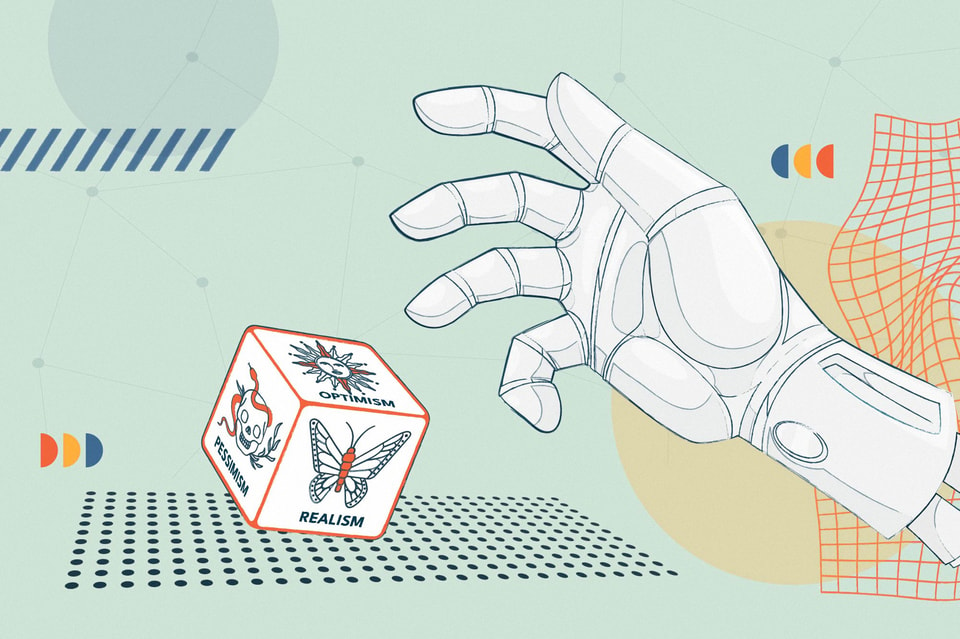Report Published January 31, 2024 · 14 minute read
AI and the US Economy: Optimism, Pessimism, or Realism?
Fredrick Hernandez, Zach Moller, & Gabe Horwitz

There were 130 websites on the internet in 1993; today there are 1.1 billion.1 Over those 30 years, the US economy quadrupled in nominal size and tripled in per capita income.2 The digital age has been very good for America.
But it has also concentrated wealth and opportunity. The richest American in 1993 would only be the 101st richest today in inflation-adjusted dollars.3 There are now 735 billionaires living in America today, compared to fewer than 75 in the world in 1993.4
Meanwhile, the gains for the middle class were not stellar. Real median household income grew a solid, but not spectacular, 32% during the internet age. Most of that gain accrued to the two-fifths of working age America with a college degree.5 “50% to 70% of the changes in the US wage structure are intimately linked to automation, particularly digital automation,” MIT economist Daron Acemoglu estimates.6
That was the digital age. What about the artificial intelligence age?
Ask McKinsey partner Michael Chui about AI and he says “it can be great not only for companies but for humankind.”7 But Eliezer Yudkowsky, co-founder of the Machine Intelligence Research Institute, said that if someone builds an over-powered AI, he expects “that every single member of the human species and all biological life on Earth dies shortly thereafter.”8
What seems clear is that whether we’re addressing the future of humankind or the well-being of the workforce, policymakers and industries must make intentional choices to get the best of AI and avoid the worst. Since AI will change the way we work and learn, this paper unpacks different economic projections to give policymakers a better read on what this technology will do to everything from American GDP to skill training.
Broadly speaking, there are three distinct perspectives on AI and the economy. Optimists predict AI will elevate the working class, accelerate our national prosperity, and lower costs. Pessimists say AI will contribute to income inequality in the United States, jobs will be automated out of existence, and large corporations will gain far more than workers and families. Pragmatists accept AI will have positive benefits to the economy but acknowledge the mixed bag of how it will affect jobs and generally call for specific actions to mitigate harms and spread benefits. Below, we explore the key takeaways from each perspective.
This is a product in a multi-year series to help educate policymakers on the implications and policy choices confronting Congress and the Administration on next generation Artificial Intelligence.
AI Optimism
Turbo-Charged Economic Growth
To optimists, AI will create a boom to productivity, innovation, and business growth. That’s the result of AI’s ability to automate or assist in regular tasks such as communication, document processing, and research.9 By automating routine tasks, workers will be able to more efficiently handle complex tasks, allowing for improved work output. One projection from Goldman Sachs anticipates that the productivity gains from AI-enabled workers would add $7 trillion in cumulative global GDP.10 In the United States, optimistic projections estimate that AI will increase annual US GDP growth between 0.5 and 1.5 percentage points annually over the next 10 years.11 That equates to somewhere between $1.2 trillion to $3.8 trillion more economic growth per decade.12
Optimists argue that productivity benefits of generative AI will also translate to a massive economic boost for businesses. McKinsey suggests AI innovation could unlock between $11-$17 trillion in increased total global economic value for business.13 These gains will occur once generative AI is widely used across industry. McKinsey projects these gains will be driven by white-collar service-based industries.
Great for Jobs
To optimists, workers are about to get a lot more productive—and in demand. For example, one study points to a call center which gave workers a generative AI assistant. The result: entry-level workers saw 30% productivity gains, while mid-level workers saw 15%, and veteran workers (interestingly) saw no gains.14 Optimists argue that this has the potential to make entry-level workers far more competitive with experienced workers. Overall, this increased economic productivity could lead to greater demand from firms to employ workers.15
Other experts believe AI will reestablish a middle-class, middle-wage job environment. That’s because generative AI will allow workers to worry less about highly specific skillsets and more on critical reasoning and general task sets. Economist David Autor, who is generally a pragmatist on AI, said that generative AI will increase access for non-college workers to compete with expert workers.16 When workers in a call center were given AI assistants, the greatest benefit was to entry-level workers, making them more competitive with call-center experts.17
AI is well-built to automate tasks such as scheduling, research, drafting, and diagnostics. Automation will therefore allow workers to focus on skills such as communication, collaboration, creative thinking, and critical analysis—things that AI doesn’t do well. Optimists predict AI will allow workers to gain greater accessibility to more complex tasks that typically require more specialized education. For example, in-home care providers may be able to better accommodate patients’ needs with AI-enabled systems such as health monitors and communication tools.18
Reduced Costs
When workers are more productive, optimists argue that it will be cheaper for businesses to provide goods and services. As a result, AI is predicted to help put downward pressure on costs.19 For example, take 3D printing. Generative AI and advances in 3D printing allow manufacturers to design and produce more unique products at scale.20 Through more efficiently designed experimental pieces, the technology could reduce costs by up to $10 million over 20 years.21 These technologies will also reduce the energy costs of manufacturing by allowing for the remanufacturing of recycled goods, translating to an 80-90% reduction in energy consumption.22
AI also has the potential to improve health care diagnostics with better analysis of medical images. AI-assisted diagnostic tools will help doctors treat illnesses earlier, and generative AI could reduce operational costs for health-care providers by up to 30%.23 Improved screening and testing from AI can also lead to lower billing expenses for patients and a quicker resolution of insurance claims.
It's worth noting that most optimists believe that laws, guidelines, and rules are necessary to bring out the best and avoid the worst of AI. However, they also believe that many of the benefits will occur organically as the market sorts things out.
AI Pessimism
Automation - the Job Killer
Pessimists think AI is about to eradicate millions upon millions of jobs. Pessimistic projections suggest 80% of today’s workers will be impacted by AI within their careers.24 Notably, a Pew Research study found that one-in-five workers were in jobs highly exposed to AI and at the highest risk for being replaced.25 Higher exposure to AI was also concentrated among those who have a college degree and have higher wages. Pew found that college-educated workers had twice the risk of exposure to AI automation than non-college workers.26 Women are at higher risks of automation exposure than men due to overrepresentation in administrative and clerical roles.27
The job threats are coming faster as well. A 2017 report by McKinsey initially reported 50% of daily work tasks could be completed with AI by 2060.28 An updated 2022 report now suggests this could occur as early as 2045.29 By 2030 alone, 12 million workers will need to have undergone occupational shifts.30 Scholars at the Brookings Institution are concerned that automation and globalization will radically change American jobs, and the types of work left will be more physical and lower-paying.31
Increase to Income Inequality
As productivity increases and production costs drop, pessimists worry that the benefits will accrue to top earners and owners of capital.
Pessimists argue that society often struggles to respond to technological change. Governments fail to understand how technology will change society. Historically, workers often have been the biggest losers while companies are the biggest winners. For example, during the automation and computer revolutions from 1978-2016, technological advancement accounted for a 60% increase in productivity—but workers only saw a 10% increase in real wages.32 AI will certainly provide productivity gains to workers and firms, but whether those workers reap a substantial share of the rewards is to be determined and by no means guaranteed.
How AI will affect China and the United States GDP
While experts do believe AI has the potential to unlock $7 trillion in GDP for the United States, it will also benefit our largest competitor, China. Projections suggest China could see a 26% GDP gain compared to a 14.5% increase for all of North America.33 China could become the largest benefactor of AI, leaving the United States struggling to compete at the global level.
Smaller Firms to Struggle
Pessimists believe the market on AI will be cornered by the largest companies. Costs to develop robust AI capabilities such as ChatGPT, Bard, or Watson are high.34 The Director of Stanford’s Human Centered AI research center has stated the largest advancements in the field of generative AI have come from large tech firms; and with a large head start, these companies will outcompete academic institutions, non-profits, and smaller firms.35
In addition, AI needs clean usable data on which to be trained.36 Training generative AI requires specific datasets to ensure machines can operate how firms intend them to. However, current data is not packaged for smaller firms to use for AI training.37 For example, a small firm may want to create a generative AI tool to help insurance companies better match policies to customers. To do this, they would need to find, organize, and package the data, which is expensive and time consuming. Companies may instead choose to license AI from larger companies with the means to get data.
Furthermore, the tight labor market for AI jobs makes it increasingly difficult for smaller organizations to attract well-trained workers.38 Capital costs are high for AI development, and hardware is costly to deploy and requires intensive tuning from engineers to ensure AI models can achieve the results firms want.39 This puts small businesses, NGOs, and the government at a disadvantage to train AI and compete. Additionally, AI advancements without a profit motive can be limited by the lack of open-source resources for governmental, non-profits, and small business to use.40
In sum, AI advances mean average Americans will be swimming against a rushing technological tide and public policy will have to push against this current just to keep them from floating out to sea. The investor class will experience AI very differently, enjoying the gains while others struggle.
AI Pragmatism
Changed Manufacturing Landscape
Pragmatists think AI will allow the economy to find ways to adapt to our rapidly changing world with the necessary public policies in place.
AI will continue the automation revolutions of the 1960s-1980s that allowed for goods to be manufactured more efficiently and at lower costs for Americans. Advances in 3D printing have ensured that machines are rapidly increasing their ability to manufacture complex products at scale for low cost. Since these machines are computerized, it is likely that AI will be integrated into these systems. This could allow for much more customizable, high-quality low-cost items to be manufactured.41 In turn, this will allow firms to produce innovative products, have more flexibility, and invest in their capabilities.
A manufacturing boom, however, does not come without a cost. For example, a survey done by the Partnership on AI found that warehouse workers employed in companies that deployed AI systems often felt heavily surveilled and evaluated on all aspects of their employment.42 As AI systems are increasingly used in evaluating worker performance, workers may become more hesitant to work in these jobs. Heavy evaluation and surveillance tools can contribute to higher burnout and emotional distress for workers who feel pressured to perform at all moments.43 This is just one small window into how AI can sacrifice fulfillment for productivity.
Changing, not Disappearing, Jobs
When ATMs came online, there was fear that bank teller jobs would disappear. In reality, the number of teller jobs increased.44 But there was a catch—the job evolved, requiring more customer service and less human money withdrawal. While the 1990s computer revolution did disrupt mid-wage administrative workers, many saw their work change, not the elimination of their job entirely. Realists look to this historical evidence and suggest AI will disrupt and cause occupational shifts, not necessarily completely eliminate jobs.
Middle-wage, non-college educated workers that will be most threatened by AI will be those in administrative positions. That’s because generative AI can complete tasks such as organizing events, inventory management, and calendar management.45 As more employers deploy AI, jobs such as secretaries, front-desk workers, paralegals, and other administrative support may struggle to maintain employment or compete against AI automation.46
While some workers may lose out, other non-college workers may gain. Firms have begun to develop and implement AI-assisted machines which help workers more effectively support customers as well as receive on-the-spot coaching from AI.47 While these machines are increasingly involved in supporting and interfacing with customers, the productivity gains have only increased demand for these workers. Even with automation, people still are skeptical of the capabilities of machines and still desire human interaction. It is unlikely that generative AI will eliminate these workers, only support them in more complex tasks.
Technical drafters who experienced AI automation saw their work shift from creation of code to the troubleshooting of the machines running the code.48 In the long run, these positions could ultimately be phased out as AI begins to correct and manage its own networks. In this instance, management skills will become of higher priority than technical knowledge.49
Expense will Slow Implementation
AI might be front page news, but realists think massive changes are at least a decade away because of the sheer cost of developing AI. More time in development means more time to adjust and prepare for different employment.
When considering past technological innovations, economists believed that in 20 years, 50% of industries would have adapted new innovations. For example, computer technologies saw their initial innovations in the 1970s, but it wasn’t until the 1990s that they become a common industry tool. Increasingly, reports are indicating AI will accelerate this timeline. A 2017 study by McKinsey suggested that AI had the potential to automate 80% of work tasks by 2055, but an updated 2023 report now believes that number will be achieved as early as 2035.50
And yet, complex data sets only allow large companies and government agencies to adapt AI technologies at the moment.51 As a result, AI innovations are heavily limited to large corporations. And unless legislation creates future requirements or congressional funding increases, AI for public or non-profit use will likely remain limited, slowing economy-wide adoption. Biden’s recent executive order may lower barriers as a National AI Research Resource is established to streamline data use by non-corporate entities, but that alone will not be enough to fully democratize AI.52
Finally, if AI follows prior trends on costly automation adoption, businesses may want to upgrade machines and techniques, but cost and human capital will limit their ability to do so. Instead, many small and medium firms will use equipment until the end of its life cycle, which will further limit adaption and disruption compared to larger companies who have capital and capability to invest into AI-integrated systems.53
Pragmatists see big changes from AI but at a speed that allows public policy, institutions, businesses, and workers to adjust. Policymakers will be tested on AI, but the speed of change is overrated.
Conclusion
AI is an important technology contributing to what some countries are calling “the fourth industrial revolution.” It could fundamentally change the nature of work and challenge how we work. But the extent of that change and the speed it occurs at is up for debate.
Optimists believe AI could represent a radical opportunity to push society closer to a wealthier, more innovative, and more prosperous future. Pessimists bemoan the threat AI poses to well-paying jobs, decreasing competition, and increasing income inequality. And pragmatists contend that generative AI will likely support innovative manufacturing, challenge the way we connect to and conduct our business within our jobs, change the nature of our work, and be limited to firms who have a need or can afford these new technologies. Ultimately, each side holds a piece of the truth. Policymakers have an important role in helping shape how AI impacts our lives, and they must consider all perspectives as we smartly regulate this new digital era.


